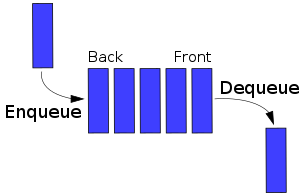1
2
3
4
5
6
7
8
9
10
11
12
13
14
15
16
17
18
19
20
21
22
23
24
25
26
27
28
29
30
31
32
33
34
35
36
37
38
39
40
41
42
43
44
45
46
47
48
49
50
51
52
53
54
55
56
57
58
59
60
61
62
63
64
65
66
67
68
69
70
71
72
73
74
75
76
77
78
79
80
81
82
83
84
85
86
87
88
89
90
| #include<cstdio>
#include<stdlib.h>
#define INF -987654321
using namespace std;
class Queue
{
private:
int max_size = 11;
int *arr;
int front = 0;
int rear = 0;
void allocate()
{
arr = (int *)malloc(sizeof(int) * max_size);
}
public:
Queue()
{
allocate();
}
Queue(int size)
{
max_size = size + 1;
allocate();
}
bool isEmpty()
{
return front == rear ? true : false;
}
bool isFull()
{
return front == (rear + 1) % max_size ? true : false;
}
void push(int a)
{
if (!isFull())
{
arr[rear] = a;
rear = (rear + 1) % max_size;
}
else
{
printf("Queue is Fulled\n");
}
}
int pop()
{
if (!isEmpty())
{
int item = arr[front];
front = (front + 1) % max_size;
return item;
}
else
{
return -INF;
}
}
};
void main()
{
Queue q1;
int push[20] = { 12, 13, 15, 16, 201, 356, 23, 76, 45, 34, 23, 23, 35, 23, 35, 46, 78, 89, 90, 21 };
int index = 0;
while (index != 20)
{
while (!q1.isFull())
{
q1.push(push[index]);
index++;
}
while (!q1.isEmpty())
{
printf("%d ", q1.pop());
}
}
}
|

